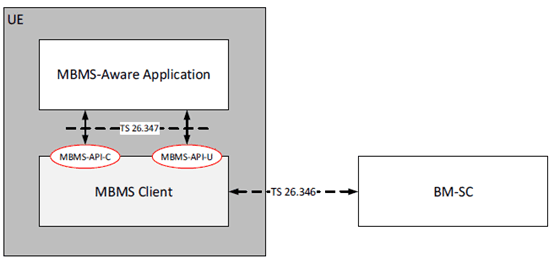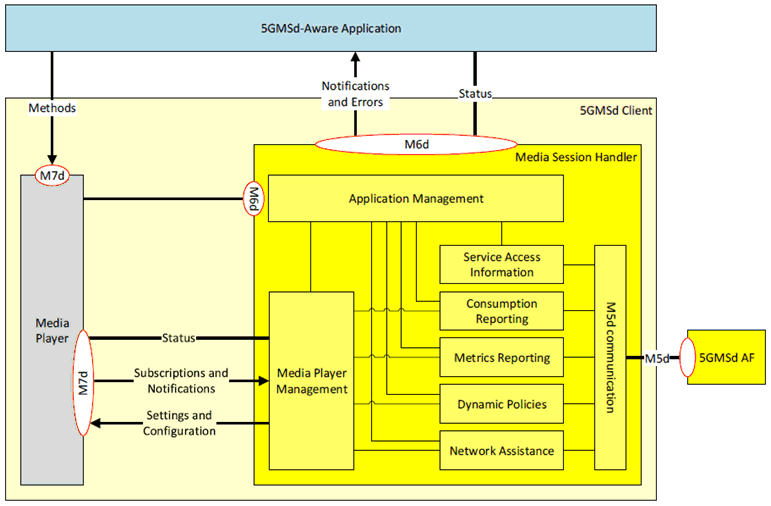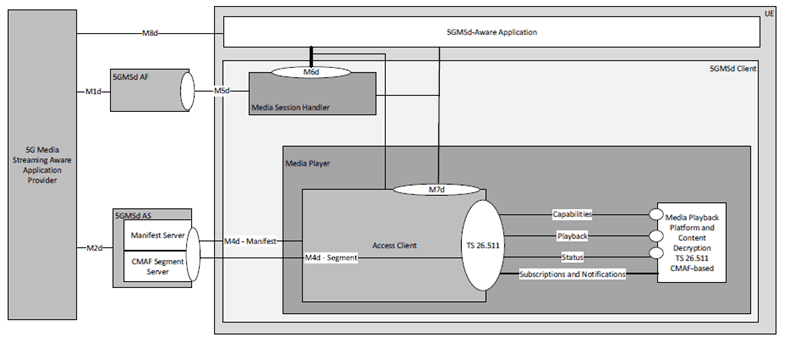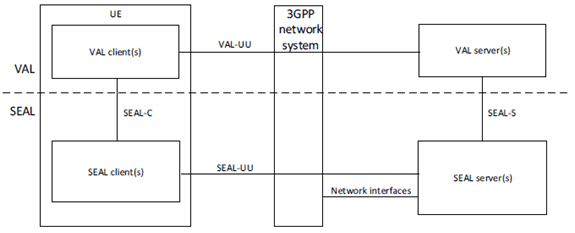Content for TR 26.857 Word version: 18.0.0
4 Motivation for Media Service Enablers
4.1 General
4.2 Examples in 3GPP
4.2.1 MBMS Client
4.2.2 Media Session Handler in 5GMS
4.2.3 Media Player in 5GMS
4.2.4 FLUS sink capability discovery
4.2.5 Service Enabler Architecture Layer (SEAL) for Verticals
...
...
4 Motivation for Media Service Enablers p. 9
4.1 General p. 9
In recent studies and specification work, it was identified that 5G Media functions and 5G System functions need to be made attractive for third-party applications, in particular those that include media delivery. Examples for such approaches are MBMS or 5G Media Streaming. Hence, it is important that these functions are accessible to third-party applications independent of a 3GPP service. For this purpose, it is considered to introduce normative specifications in 3GPP that are:
- More than just a core functionality, e.g. a codec, without any connection to a service or application.
- Less than a full service that includes all aspects of session establishment, delivery, codecs, rendering and a full user experience.
4.2 Examples in 3GPP p. 10
4.2.1 MBMS Client p. 10
An example for the definition of an API-centric component in a 3GPP specification is one that serves the MBMS Client. The detailed procedures of the MBMS Client are defined in TS 26.346 and TS 26.347 according to Figure 4.2.1-1.

Figure 4.2.1-1: MBMS Client - Application and Network reference Points an APIs
(⇒ copy of original 3GPP image)
(⇒ copy of original 3GPP image)
In particular, TS 26.347 defines the following aspects:
Reception of data from an MBMS bearer is triggered following the code in Listing 4.2.1-2.
Listing 4.2.1-2 Reception of data from an MBMS bearer using Android APIs
Finally, the multicast packet data is accessed by the execution shown in Listing 4.2.1-3.
Listing 4.2.1-3 Multicast packet data access using Android APIs
- A set of service APIs for different application user services. The definition provides the ability to independently develop MBMS-Aware Applications and MBMS Client implementations, even for different operating systems and execution environments, but relies on the service APIs to communicate with the MBMS Client and to make use of the MBMS functionalities. These APIs are referred to as MBMS-API-C.
- A set of interface options between the MBMS Client and the application to support the transfer of user data. The primary focus is on the communication through network interfaces, for example the usage of IP sockets or HTTP-based requests. These APIs are referred to as MBMS-API-U.
- A client state model in relation to the application. Examples for state are IDLE, REGISTERED, ACTIVE, etc. State changes may occur through MBMS-API-C or by information received through the network interface.
- A set of client internal parameters that are changed based on either configuration or API calls through MBMS-API-C or by information received through the network interface.
- A reference description of the operation of the MBMS client in different states, based on through MBMS-API-C or by information received through the network interface
-
Different methods that allow the application to communicate with the MBMS client. For each method, the following information is provided:
- A high-level description of the method.
- An example call flow illustrating usage of the method.
- A list of input and output parameters that are exchanged as part of the method invocation.
- A description of the usage of the method by the application.
- the MBMS Client actions in response to the invocation of the method, including pre- and post-conditions.
-
Download Session: https://
developer. android. com/ reference/ android/ telephony/ MbmsDownloadSession -
Group Call Session: https://
developer. android. com/ reference/ android/ telephony/ MbmsGroupCallSession -
Streaming Session: https://
developer. android. com/ reference/ android/ telephony/ MbmsStreamingSession -
MBMS API documentation: https://
developer. android. com/ reference/ android/ telephony/ mbms/ package-summary
4.2.2 Media Session Handler in 5GMS p. 13
Another example enabling function relevant to 5G media delivery is the Media Session Handler defined in TS 26.501 (stage-2) and TS 26.512 (stage-3). The Media Session Handler is a function on the UE that communicates with the 5GMSd AF in order to establish, control and support the delivery of a media session, and may perform additional functions such as the collection and reporting of consumption and QoE metrics. The Media Session Handler exposes APIs that can be used by the 5GMSd-Aware Application. An overview is provided in Figure 4.2.2-1.

Figure 4.2.2-1: Media Session Handler- Application and Network reference Points an APIs
(⇒ copy of original 3GPP image)
(⇒ copy of original 3GPP image)
(Reproduced from TS 26.512)
The Media Session Handler deals with three sets of APIs and reference points:
- M5d (Media Session Handling API): APIs exposed by a 5GMSd AF to the Media Session Handler for media session handling, control, reporting and assistance that also include appropriate security mechanisms, e.g. authorization and authentication.
- M6d (UE Media Session Handling APIs): APIs exposed by a Media Session Handler to the Media Player for client-internal communication and exposed to the 5GMSd-Aware Application enabling it to make use of 5GMS functions.
- M7d (UE Media Player APIs): APIs exposed by a Media Player to the 5GMSd-Aware Application and Media Session Handler to make use of the Media Player.The APIs for M6d and M7d are defined in an abstract manner at this stage.
4.2.3 Media Player in 5GMS p. 14
Downlink 5G Media Streaming specifies the use of segment formats that are based on the Common Media Application Format (CMAF) in ISO/IEC 23000-19 [14]. By using this format, 5G Media Streaming is compatible with a broad set of segment-based streaming protocols including Dynamic Streaming over HTTP (DASH) and HTTP Live Streaming (HLS). For example, ISO/IEC 23009-1 [15] defines a detailed DASH profile for delivering CMAF content within a DASH Media Presentation using a converged format for segmented media content.

Figure 4.2.3-1: Media Playback in 5G Media Downlink Streaming Architecture
(⇒ copy of original 3GPP image)
(⇒ copy of original 3GPP image)
(reproduced from TS 26.511)
According to TS 26.511, TS 26.512 and Figure 4.2.3-1 above, the Media Player is further decomposed into an Access Client and a Media Playback Platform. Several APIs are identified for the Media Player:
cdn.dashjs.org/latest/jsdoc , but they are abstract.
For the Media Player, different states are defined, depending on actions received from any of the APIs.
- M4d (Media Streaming APIs): APIs exposed by a 5GMSd AS to the Media Player to stream media content.
- M6d (UE Media Session Handling APIs): APIs exposed by a Media Session Handler to the Media Player for client-internal communication and exposed to the 5GMSd-Aware Application enabling it to make use of 5GMS functions.
- M7d (UE Media Player APIs): APIs exposed by a Media Player to the 5GMSd-Aware Application and Media Session Handler to make use of the Media Player.
- A set of internal Media Player APIs that deals with providing accessed data to the Media Playback Platform. These closely follow the W3C APIs for HTML-5 based media playback and the Media Source Extensions.
- Methods to interact with the Access Client of the Media Player,
- Notification and Error Events sent to the Media Session Handler and 5GMSd-Aware Application,
- Configuration and Settings methods,
- Status Information.
4.2.4 FLUS sink capability discovery p. 15
TS 26.238 defines a set of protocols for uplink media streaming. This specification includes a method for describing the processing capabilities of the entity (known as FLUS sink) that receives the uplink stream. In this specification, these capabilities are described as a list. Each entry in the list includes a scheme identifier, the location for the description of the scheme, and a URL where the specific capability can be accessed. The FLUS sink capabilities description can be retrieved from the sink or it can be found in a sink directory.
The advantage of the FLUS sink capabilities description is its simplicity. However, since each item in the capabilities list has its own scheme, it does not provide much interoperability for describing the available functions and their detailed features, since each function defines its own scheme for describing its capabilities.
4.2.5 Service Enabler Architecture Layer (SEAL) for Verticals p. 15
SA6 defines several Application Frameworks, for example Service Enabler Architecture Layer for Verticals (SEAL). TS 23.434 specifies the functional architecture of the Service Enabler Architecture Layer (SEAL) and the procedures, information flows and APIs for each service within SEAL in order to support vertical applications over the 3GPP system. To ensure efficient use and deployment of vertical applications over 3GPP systems [8] includes the group management, configuration management, location management, identity management, key management and network resource management. Figure 4.2.5-1 illustrates the generic on-network functional model for SEAL.

Figure 4.2.5-1: Generic on-network functional model for SEAL (see TS 23.434, Figure 6.2-1)
(⇒ copy of original 3GPP image)
(⇒ copy of original 3GPP image)
In the vertical application layer (VAL), the VAL client communicates with the VAL server over reference point VAL-UU. This supports both unicast and multicast delivery modes, but is otherwise out of scope of SEAL.
The SEAL functional entities on the UE and the server are grouped into SEAL client(s) and SEAL server(s) respectively. The SEAL consists of a common set of services (e.g. group management, location management) and reference points. The SEAL offers its services to the vertical application layer (VAL). The functionalities and reference points of the vertical application layer are out of scope of SEAL.
- Each SEAL client communicates with its SEAL server over reference point SEAL-UU.
- The SEAL client provides the service enabler layer support functions to the VAL client over reference point SEAL-C.
- Each VAL server communicates with its SEAL server over reference point SEAL-S.